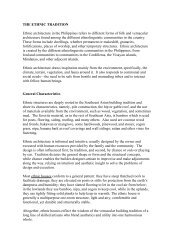THE ETHNIC TRADITION IN PHILIPPINE MUSIC ... - About Philippines
THE ETHNIC TRADITION IN PHILIPPINE MUSIC ... - About Philippines
THE ETHNIC TRADITION IN PHILIPPINE MUSIC ... - About Philippines
You also want an ePaper? Increase the reach of your titles
YUMPU automatically turns print PDFs into web optimized ePapers that Google loves.
(sulibao and kimbal), and a pair of metal bars (palas). There is a variety of<br />
heterogenous combinations of instruments and instrumental timbres in the<br />
Mindanao ensembles. The Yakan tagunggo ensemble consists primarily of a brass<br />
kwintangan, gabbang, a set of three agung, and cracked bamboo slit drum<br />
(gandang). The Maguindanao kulintangan is composed of a kulintang, babandir,<br />
four gandingan, a pair of agung, and a dabakan.<br />
In the rural Christian communities, instrumental ensembles besides the brass band,<br />
rondalla, and other folk ensembles such as the musikong bumbong, pangkat<br />
kawayan, and the cumbanchero, vary in number of members and instrumentation.<br />
A group may consist of a clarinet, violin, bumbong, bandurria, banjo, guitar, and<br />
bajo de uñas (local version of a double bass). The five-stringed guitar is a common<br />
accompanying and harmonic instrument. The cumbanchero flourished in the<br />
1950s as an offshoot of the popularity of the “King of Rhumba” Xavier Cugat.<br />
The instrumentation of the cumbanchero consisted of a harmonica (the principal<br />
melody instrument), maracas, claves, guitar, bongos, conga drum, jawbone, guiro,<br />
guitar, and one-stringed bass improvised from a war surplus portable gasoline<br />
tank. The accordion was also included when available.<br />
Indigenous and adopted instruments which are used for solo or small group<br />
performances include the different flutes, jew’s harp, zither, xylophone, lute,<br />
kulintang, harp, bandurria, and the guitar.<br />
Philippine musical instruments and their repertoires are unique in their degree of<br />
indigeneity and hybridization of instruments and music. Indigenous instruments<br />
used to play indigenous music are mostly metallophones and idiophones, as well<br />
as bamboo chordophones and aerophones. Asian-derived instruments tuned to<br />
Western temperament and used to play music in the Western idiom are the blown<br />
bamboo tubes (bumbong), angklung, and tipanu (Cuyunon flute). Westernadapted<br />
instruments used to play Western music are the guitar and other plucked<br />
strings (bandurria, octavina, laud, mandola, bajo de uñas), and brass band and<br />
orchestra instruments. Western-adapted instruments used to play Western music<br />
are those found in the musikong bumbong and cumbanchero groups. Westernadapted<br />
instruments used to play non-Western music are the Hanunuo gitgit,<br />
Tausug biyula, and Aeta biolin.The Vocal Genres<br />
In most tribal communities that have no generic name for vocal music (or “music”<br />
for that matter), each vocal genre bears a specific name, usually referring not only<br />
to the musical and textual contents but also to its social role. The vocal repertoire<br />
consists of a great variety of types, forms, styles, uses, and functions.<br />
While instrumental music is generally performed on different occasions (except for<br />
the bangibang music of the Ifugao which is heard exclusively at the himong ritual<br />
and the Yakan kwintangan kayu or daluppal music played for agricultural<br />
purposes), vocal music is function specific. Songs refer to particular occasions or<br />
activities and express individual feelings and emotions. Many songs are as







